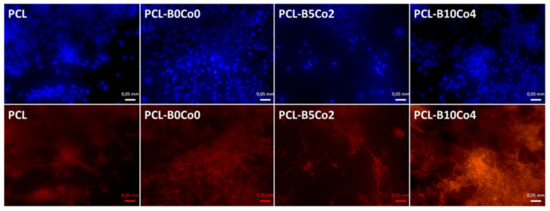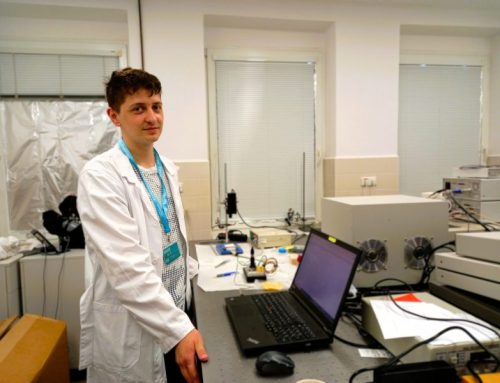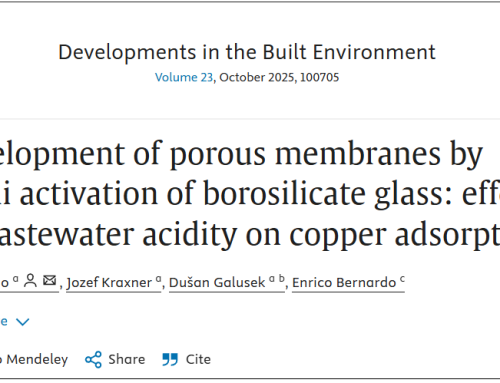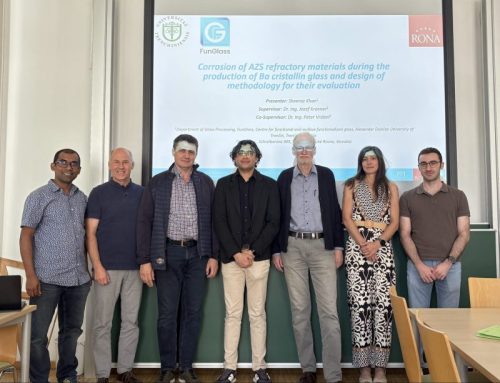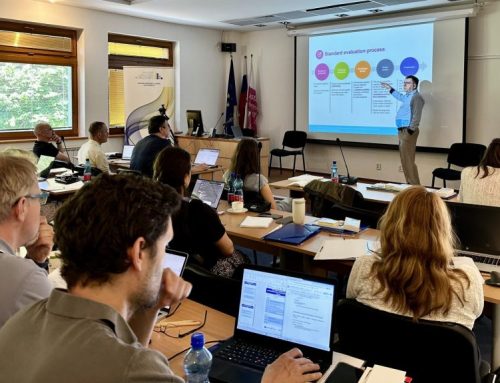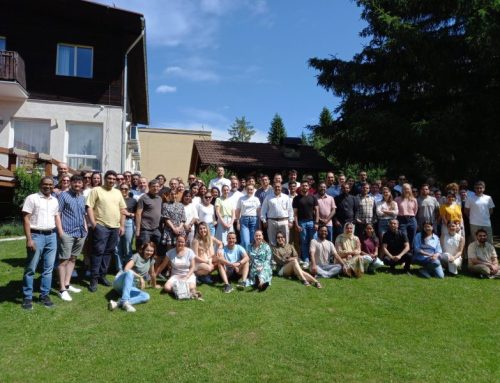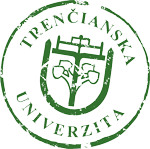New articles published by FunGlass
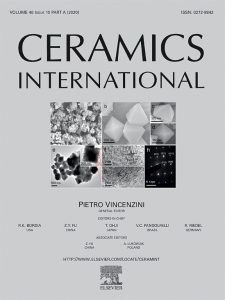 F. Sharifianjazi, M. Moradi, A. Abouchenari, A. Pakseresht, A. Esmaeilkhanian, M. Shokouhimehr, M. S. Asl: Effects of Sr and Mg dopants on biological and mechanical properties of SiO2–CaO–P2O5 bioactive glass. In: Ceramics International, Volume 46, Issue 14, 1 October 2020, Pages 22674-22682.
F. Sharifianjazi, M. Moradi, A. Abouchenari, A. Pakseresht, A. Esmaeilkhanian, M. Shokouhimehr, M. S. Asl: Effects of Sr and Mg dopants on biological and mechanical properties of SiO2–CaO–P2O5 bioactive glass. In: Ceramics International, Volume 46, Issue 14, 1 October 2020, Pages 22674-22682.
https://doi.org/10.1016/j.ceramint.2020.06.030
Abstract: In the present study, the effects of Sr and Mg were investigated on mechanical and biological properties of 58S bioactive glass (BG). SiO2-P2O5-CaO BG with different contents of Sr and Mg were synthesized via the sol-gel method and immersed in simulated body fluid (SBF) for several days to explore their biocompatibility. Precise analyses of the BG using X-ray powder diffraction, scanning electron microscopy, and transmission electron microscopy showed that the Mg-doped BG containing 8 wt % MgO possessed better biocompatibility. It was also found that mechanical properties of the BG could be improved by increasing the amounts of MgO and SrO. Both 5Sr-BG and 8Mg-BG samples did not exhibit any cytotoxicity while showing high alkaline phosphatase activity in comparison with control specimens. However, the Sr-doped BG sample including 5 wt % SrO demonstrated enhanced bioactivity and biocompatibility.
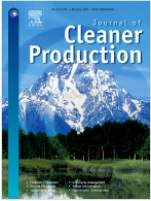 D. D. Ramteke, M. Hujova, J. Kraxner, D. Galusek, A. R. Romero, R. Falcone, E. Bernardo: Up-cycling of ‘unrecyclable’ glasses in glass-based foams by weak alkali-activation, gel casting and low-temperature sintering. In: Journal of Cleaner Production, Volume 278 (2021), 123985.
D. D. Ramteke, M. Hujova, J. Kraxner, D. Galusek, A. R. Romero, R. Falcone, E. Bernardo: Up-cycling of ‘unrecyclable’ glasses in glass-based foams by weak alkali-activation, gel casting and low-temperature sintering. In: Journal of Cleaner Production, Volume 278 (2021), 123985.
https://doi.org/10.1016/j.jclepro.2020.123985
Abstract: A significant amount of glasses is landfilled because mainstream recycling solutions do not address the articles of specific chemical compositions, including opal glass and glass fibers residues. This manuscript suggests the up-cycling of these glasses through the production of highly porous glass foams. Fine glass powders were dispersed in weakly alkaline solutions, which were foamed by the combination of surfactant addition and intensive mechanical stirring. The cellular structures were stabilized first by the gelation of suspensions, upon drying, then by viscous flow sintering at 700–800 °C, for 10–60 min. The foams based on glass fibers reached an excellent strength-to-density ratio, due to the formation of closed cells and partial crystallization. The foams made from opal glass maintained a particularly uniform open porosity, and importantly, also retained the volatile and toxic fluorine due to the rapid, low-temperature sintering.
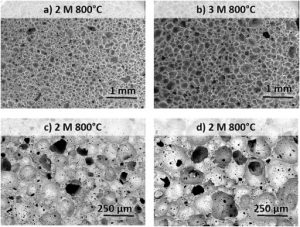
![]()
K. Faturíková, T. Gavenda, M. Liška, P. Viščor: Dielectric properties of barium crystal glass. In: Ceramics-Silikáty 64 (4), 379-386 (2020)
doi: 10.13168/cs.2020.0025
Abstract: The temperature dependence of impedance spectra of industrially produced (RONA, Lednické Rovne, Slovakia) barium crystal glass was studied. The linear dependence of complex impedance on the sample thickness was used for separating the bulk dielectric properties from the electrode boundary effects. The temperature dependence of direct current conductivity was evaluated from the Nyquist plots. The ZARC circular line was adjusted to the Nyquist plots by the least squares method. The distribution of relaxation times in impedance was evaluated this way. More detailed analysis of impedance spectra was performed by the equivalent circuit method in capacitance. Four relaxation processes were identified this way.
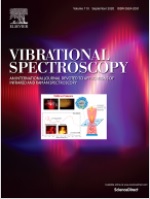 B. Hruška, T. Gavenda, F. Vašíček, R. Svoboda: Raman spectroscopy study of glass corrosion. In: Vibrational Spectroscopy, Volume 109, 2020
B. Hruška, T. Gavenda, F. Vašíček, R. Svoboda: Raman spectroscopy study of glass corrosion. In: Vibrational Spectroscopy, Volume 109, 2020
https://doi.org/10.1016/j.vibspec.2020.103096
Abstract: Binary sodium silicate and potassium silicate glasses with different alkali content were exposed to the corrosion environment of 35 % hydrochloric acid (HCl). Glass samples were measured by Raman spectroscopy and the spectra were compared with Raman spectra of original pristine glasses in order to observe structural changes induced by corrosion within the surface layer. The usage of confocal Raman spectroscope enabled the measurement of Raman spectra from the depths of few micrometres to document the range of structural changes. The results suggest the depolymerisation of silicate structure due to the growth of the corrosion layer on the surface. The decrease of D2 peak points at the decomposition of three-membered rings. In addition, it is assumed that the Si-O-Si angle changes within the surface layer.
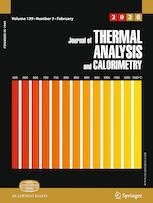 B. Hruška, R. Dagupati, M. Chromčíková, A. Nowicka, J. Macháček: Thermodynamic model and Raman spectra of MgO–P2O5 glasses. In: Journal of Thermal Analysis, 142, 2025–2031 (2020).
B. Hruška, R. Dagupati, M. Chromčíková, A. Nowicka, J. Macháček: Thermodynamic model and Raman spectra of MgO–P2O5 glasses. In: Journal of Thermal Analysis, 142, 2025–2031 (2020).
https://doi.org/10.1007/s10973-020-10033-1
Abstract: The structure of binary glasses xMgO·(1−x)P2O5 (x = 0.30, 0.35, 0.40, 0.45, 0.50, and 0.55) was studied by thermodynamic model (TDM) of Shakhmatkin and Vedishcheva (SV) and Raman spectroscopy. In the TDM, six following system components were considered: MgO (M), P2O5 (P), MgO·2P2O5 (MP2), MgO·P2O5 (MP), 2MgO·P2O5 (M2P), 3MgO·P2O5 (M3P). The principal component analysis (PCA) of experimental Raman spectra resulted in three independent components. The baseline subtracted and thermally corrected Raman spectra were analyzed by the multivariate curve analysis (MCR) for three components. The MCR resulted in the Raman spectra and relative abundance of each component. The experimental spectra were reproduced by the MCR on the level of 99.9%. Correlation analysis attributed the MCR components to M2P, MP, and MP2. Then the Malfait’s decomposition was performed based on the TDM-SV equilibrium molar amounts of system components (MP2, MP, and M2P) resulting in partial Raman spectra (PRS). Normalized MCR loadings coincide with normalized PRS. Adjusted scores were reproduced with good accuracy equilibrium molar amounts of system components.
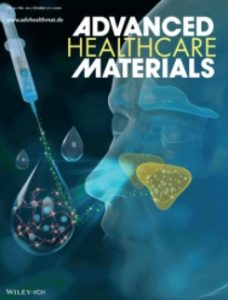 S. Pourshahrestani, E. Zeimaran, N. A. Kadri, N. Mutlu, A. R. Boccaccini: Polymeric Hydrogel Systems as Emerging Biomaterial Platforms to Enable Hemostasis and Wound Healing. In: Advanced Healthcare Materials, Volume 9, Issue 20, 2020
S. Pourshahrestani, E. Zeimaran, N. A. Kadri, N. Mutlu, A. R. Boccaccini: Polymeric Hydrogel Systems as Emerging Biomaterial Platforms to Enable Hemostasis and Wound Healing. In: Advanced Healthcare Materials, Volume 9, Issue 20, 2020
https://doi.org/10.1002/adhm.202000905
Abstract: Broad interest in developing new hemostatic technologies arises from unmet needs in mitigating uncontrolled hemorrhage in emergency, surgical, and battlefield settings. Although a variety of hemostats, sealants, and adhesives are available, development of ideal hemostatic compositions that offer a range of remarkable properties including capability to effectively and immediately manage bleeding, excellent mechanical properties, biocompatibility, biodegradability, antibacterial effect, and strong tissue adhesion properties, under wet and dynamic conditions, still remains a challenge. Benefiting from tunable mechanical properties, high porosity, biocompatibility, injectability and ease of handling, polymeric hydrogels with outstanding hemostatic properties have been receiving increasing attention over the past several years. In this review, after shedding light on hemostasis and wound healing processes, the most recent progresses in hydrogel systems engineered from natural and synthetic polymers for hemostatic applications are discussed based on a comprehensive literature review. Most studies described used in vivo models with accessible and compressible wounds to assess the hemostatic performance of hydrogels. The challenges that need to be tackled to accelerate the translation of these novel hemostatic hydrogel systems to clinical practice are emphasized and future directions for research in the field are presented.
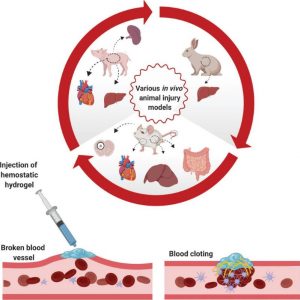
 A. Prnová, J. Valúchová, N. Mutlu, M. Parchovianský, R. Klement, A. Plško: Thermal behaviour and photoluminescence properties of Er- and Nd-doped yttrium aluminate glasses. In: Journal of Thermal Analysis and Calorimetry. Volume 142, 129- 138 (2020)
A. Prnová, J. Valúchová, N. Mutlu, M. Parchovianský, R. Klement, A. Plško: Thermal behaviour and photoluminescence properties of Er- and Nd-doped yttrium aluminate glasses. In: Journal of Thermal Analysis and Calorimetry. Volume 142, 129- 138 (2020)
https://doi.org/10.1007/s10973-020-09816-3
Abstarct: Yttrium aluminate glasses (76.8 mol% of Al2O3, 23.2 mol% of Y2O3) doped with Er3+ and Nd3+ ions at different concentration levels (0.25 mol%, 0.5 mol% and 0.75 mol% Er2O3/Nd2O3) were prepared by flame synthesis in the form of glass microspheres. The prepared samples were XRD amorphous, without presence of any crystalline phases in measured patterns. The two exothermic effects (~ 940, ~ 1010 °C), which can be assigned to the two steps of YAG crystallization, were observed in the DSC records of all prepared samples. The high temperature XRD measurements showed YAG (900–1200 °C) and α-Al2O3 (1300–1450 °C) phase crystallization. The emission spectra were measured in the VIS and NIR regions for Er-doped samples and in the NIR region for Nd-doped samples. All measured emission spectra contain of characteristic bands due to the typical 4f–4f transitions within the Er3+ and Nd3+ ions. Comparison of the measured intensities of Er-doped samples made it evident that the highest intensities were obtained for the 0.5 mol% Er2O3-doped sample (in both the NIR and VIS spectral regions). The maximum intensity for Nd-doped samples was found when the sample was doped with 0.75 mol% of Nd2O3. The slowly increasing of emission intensities in samples after 20 min annealing at 1000 °C and Stark splitting of emission bands in samples after 40 and 60 min annealing at 1000 °C and after 20, 40 and 60 min annealing at 1500 °C was observed.
![]() S. Chen, D. Galusková, H. Kaňková, K. Zheng, M. Michálek, L. Liverani, D. Galusek, A. R. Boccaccini: Electrospun PCL Fiber Mats Incorporating Multi-Targeted B and Co Co-Doped Bioactive Glass Nanoparticles for Angiogenesis. In: Materials 2020, 13(18), 4010.
S. Chen, D. Galusková, H. Kaňková, K. Zheng, M. Michálek, L. Liverani, D. Galusek, A. R. Boccaccini: Electrospun PCL Fiber Mats Incorporating Multi-Targeted B and Co Co-Doped Bioactive Glass Nanoparticles for Angiogenesis. In: Materials 2020, 13(18), 4010.
https://doi.org/10.3390/ma13184010
Abstract: Vascularization is necessary in tissue engineering to keep adequate blood supply in order to maintain the survival and growth of new tissue. The synergy of biologically active ions with multi-target activity may lead to superior angiogenesis promotion in comparison to single-target approaches but it has been rarely investigated. In this study, polycaprolactone (PCL) fiber mats embedded with B and Co co-doped bioactive glass nanoparticles (BCo.BGNs) were fabricated as a tissue regeneration scaffold designed for promoting angiogenesis. BCo.NBGs were successfully prepared with well-defined spherical shape using a sol-gel method. The PCL fiber mats embedding co-doped bioactive glass nanoparticles were fabricated by electrospinning using benign solvents. The Young’s moduli of the nanoparticle containing PCL fiber mats were similar to those of the neat fiber mats and suitable for scaffolds utilized in soft tissue repair approaches. The mats also showed non-cytotoxicity to ST-2 cells. PCL fiber mats containing BCo.BGNs with a relatively high content of B and Co promoted the secretion of vascular endothelial growth factor to a greater extent than PCL fiber mats with a relatively low B and Co contents, which demonstrates the potential of dual ion release (B and Co) from bioactive glasses to enhance angiogenesis in soft tissue engineering.
